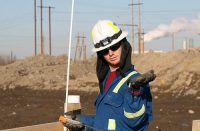KIDS ARE SMART. They get it. Over the past year, I have spoken to hundreds of university students in Eastern Canada. First, I present scientific evidence that demands we put a price on carbon and move to a low-carbon economy. Next, I pose the question: Which sectors will be the winners and which will be the losers in this new economy?
KIDS ARE SMART. They get it. Over the past year, I have spoken to hundreds of university students in Eastern Canada. First, I present scientific evidence that demands we put a price on carbon and move to a low-carbon economy. Next, I pose the question: Which sectors will be the winners and which will be the losers in this new economy?
Even before the bailouts of GM and Chrysler, these students identified the automobile industry, especially North America’s Big Three, as a loser in a low-carbon economy. Moreover, they cited the manufacturing and operation of transit vehicles as potential winners.
As these kids recognize, climate change will help some sectors, and hurt others. The fear of creating losers explains, in part, why successive governments have been incapable of enacting policies that will embrace the opportunities inherent in a low-carbon economy. But while Canada is dithering, our list of environmental sins is mounting. We now produce more greenhouse gas emissions per capita than any other country in the world. Meanwhile, we are failing to capitalize on the green job market despite mounting evidence of the promise it holds.
Most Canadians believe that a clean environment and a strong economy can be achieved at the same time, according to an October 2008 Environics poll. By a margin of more than 2 to 1, it found that Canadians want the federal government to give equal priority to both the economy and the environment. The raft of blue-green alliances between the labour movement (e.g., United Steelworkers, Alberta Federation of Labour) and environmental groups (e.g., Sierra Club, Greenpeace) indicates that these organizations also see promise in green jobs as a means of accomplishing both.
While the transition from a brown to a green economy may not be as straightforward or painless as many might wish, only governments seem to be hanging on to the notion that a choice must be made between job creation and environmental protection. Federal ministers, including Environment Minister Jim Prentice, continue to trot out tired, false lines about jobs versus the environment.
In its September 2008 report, Green Jobs: Towards Decent Work in a Sustainable, Low-Carbon World, the United Nations Environment Programme (UNEP) debunked the “jobs versus the environment” argument. The report concludes that a global shift toward a low-carbon, sustainable economy can be an engine for development, adding large numbers of green jobs across many sectors. It argues that the global pace of green-job creation is likely to accelerate in the years ahead, but that increased investment is essential to develop these jobs and facilitate a just transition.
UNEP reports that Europe, the United States, Brazil and China are adopting policies that advance sustainability by generating green jobs more cost-effectively than traditional job-creation efforts. Some 250,000 people are already employed in Germany’s growing renewable energy sector. California expects to create a job for each of the one million solar panels it has committed to installing. The Obama Administration’s 2009 economic stimulus package includes $11-billion (US) for green jobs tied to improving the environmental performance of homes.
Despite federal inaction in Canada, the green-jobs market has been heating up. Environmental Careers Organization (ECO) Canada has been tracking environmental employment in this country since 1992. A 2007 ECO Canada survey found that the green job market is growing 60 per cent faster than employment in the overall Canadian economy. In fact, the sector now employs over three per cent of Canada’s workforce, and in 2006 there were 530,000 environmental jobs versus 221,000 in 1998. Furthermore, Ontario’s new Green Energy Act could create as many as 90,000 green-collar jobs according to a study released in June by World Wildlife Fund-Canada, Blue Green Canada and the Green Energy Act Alliance.
Nonetheless, with a stubbornness that’s hard to comprehend, the federal and Alberta governments continue to wallow in brown economic mud. And they aren’t content to simply ignore green jobs. Instead, Stephen Harper’s Conservatives seem to be waging a war against them. The 2009 federal economic-stimulus plan replaced the successful ecoENERGY program for renewables with a $2-billion program that mainly subsidizes carbon capture and storage (CCS) technology for the oil sands industry. It’s a move that will create very few jobs per dollar invested, according to the UNEP report. In its 2008 interim report, Accelerating Carbon Capture and Storage in Alberta, the Alberta Carbon Capture and Storage Development Council indicates that the technology will cost between $75 and $115 per tonne of carbon dioxide (CO2). Given that carbon emissions credits are currently trading in the range of $25 per tonne of CO2 on the European Climate Exchange, this would be an expensive way to reduce greenhouse gas emissions. So expensive in fact, that eight oil sands companies have abandoned their bids for a share of the $2-billion subsidy that the Alberta government has set aside for CCS projects.
Labour-intensive investments to improve the energy efficiency of Alberta homes, offices and industries would have been a far cheaper and more effective way to create green jobs and reduce greenhouse gas emissions, according to Green Jobs: It’s time to build Alberta’s future, a recent report David Thompson prepared for Sierra Club Prairie Chapter, Greenpeace and the Alberta Federation of Labour. The study found, for example, that a home-energy-retrofit program for Alberta would cost between $0.9-billion and $1.9-billion (compared to $4.5-billion in recent subsidies to the fossil fuel industry) and would generate between 10,000 and 22,000 direct and indirect jobs. Thompson concluded that it would be “remarkably affordable” to move to a green-jobs strategy in Alberta that included energy efficiency.
So what is a green job anyway? The UNEP report defines it as work that “contributes substantially to preserving or restoring environmental quality. Specifically, but not exclusively, this includes jobs that help to protect ecosystems and biodiversity; reduce energy, materials, and water consumption through high-efficiency strategies; de-carbonize the economy; and minimize or altogether avoid generation of all forms of waste and pollution.” But UNEP doesn’t stop there. It factors in equity as well. “Green jobs need to be decent work, i.e., good jobs which offer adequate wages, safe working conditions, job security, reasonable career prospects, and worker rights.”
Green-jobs strategies usually focus on the clearest winners: economic sectors that are likely to profit the most from greenhouse gas emission reductions. Energy efficiency retrofits of residential, commercial and industrial infrastructure often enjoy pride of place in these schemes because they can be launched quickly, and since investments usually pay for themselves. These programs also rely on public investments in wind, solar and biofuel energy generation, and support for manufacturing and development of urban and intercity transit systems.
But even the most advanced green-jobs strategies are not enough to achieve a truly sustainable economy. Most do not encompass the radical transformation of our carbon-based economy to one that will avoid catastrophic climate change. They tend to assume that the future will be much like the past, with gradual, linear shifts away from fossil fuels toward sustainable energy use that is managed seamlessly by markets, and increased costs for carbon emissions.
But climate change is not likely to be gradual or linear, according to the Intergovernmental Panel on Climate Change. Sudden dramatic and catastrophic events are expected to become increasingly frequent, so the transformation to a sustainable, green-jobs economy may need to be non-linear as well.
The overwhelming consensus of climate scientists is that global greenhouse gas emissions must be reduced by 25 to 40 per cent by 2020, and 80 to 90 per cent by 2050 if a two-degree increase in average temperatures is to be avoided. This two-degree threshold is seen as the likely trigger point for global climate chaos. As the warming atmosphere generates more frequent and intense floods, droughts and severe storms, which will lead to economic dislocation and human misery, political pressure to achieve a low-carbon economy will mount. Peaking global oil supplies set against increasing global demands for fossil fuels, especially within developing countries, will also accelerate the demand for green jobs.
If Canada were to lower its carbon emissions by, for instance, 25 per cent from 1990 levels by 2020, fossil fuel prices will rise. As a result, energy efficient and low-carbon sectors would enjoy economic, political and social advantages, while carbon-intensive industries would be the losers.
Governments are understandably reluctant to talk about losing industries and brown jobs in their green-jobs strategies. But the students I’ve been addressing are not so shy. They agree that the airline industry will likely be in deep trouble in a low-carbon economy, since a passenger plane flying return between Toronto and Vancouver generates as much carbon (one tonne) as the average person from India does in an entire year. Long-distance vacationing will become prohibitively expensive, and countries dependent on this type of tourism are vulnerable. Vacationers will stay closer to home, thereby shifting business and jobs.
Long-distance trucking and shipping would also decline, as costs increase for moving products such as Mexican tomatoes, South African wine and Israeli red peppers to Canadian markets. Production and distribution of food and other consumer goods closer to markets in major urban centres would likely be winners in terms of green jobs and business investment.
Oil sands development would be a major loser in a low-carbon economy, since its production of oil is three times more carbon intensive than conventional oil industries. Technology to capture and store carbon emissions in geological formations will take some time to be feasible, and may be prohibitively expensive. A June 2009 report published by the Pembina Institute concludes that “Large-scale carbon capture and storage for oil sands emissions is currently a distant and uncertain prospect.” A far better low-carbon, green-jobs strategy, such as Ontario’s Green Energy Act, is to promote renewable energy sources and tie them into a smart, distributed power grid that will allow businesses and households to produce their own energy and share it with each other.
It’s not as if we haven’t had winners and losers before. Think about film developers and CD stores and tobacco farmers and even daily newspapers. Success for businesses in the future will be based on carbon-intensity as much as on fiscal prudence. Carbon will be our new “greenback.” As employment conforms, education will have to change too. This has enormous implications for the students who have been attending my talks. Fortunately, kids are smart. They get it and can adapt quickly. The trick for our governments is to get over their fear of losers, and then plan for a future that is becoming increasingly clear to all but the most stubborn.
Speaking from experience, Stephen Hazell, executive director of the Sierra Club Canada Foundation, thinks that folks with green jobs have more fun.












